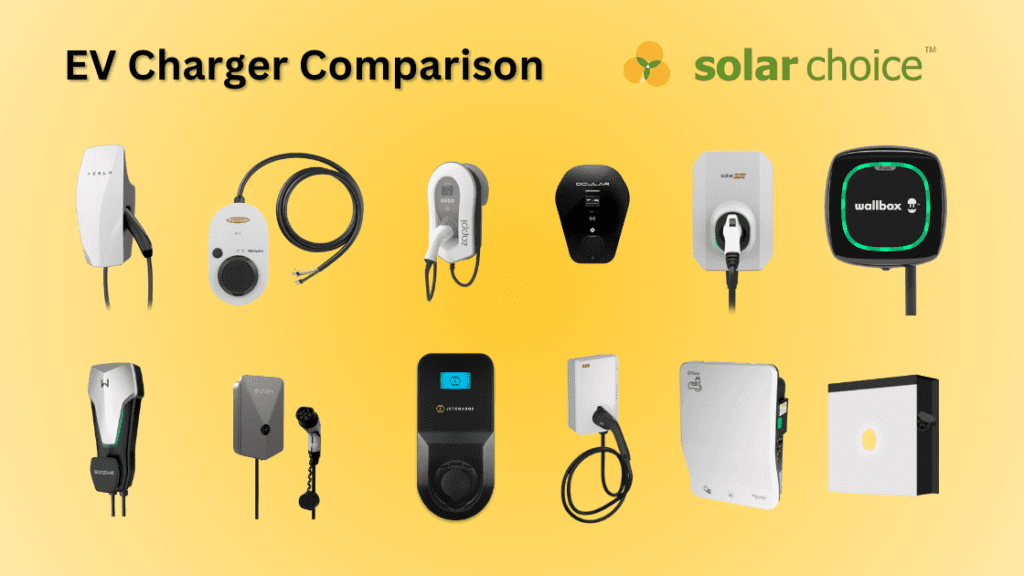Compare EV Charger quotes from trusted installers
Compare The Best Home EV Chargers
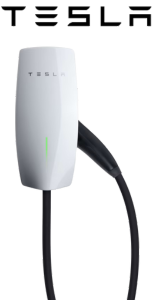
Tesla
EV Charger
Office in Australia:
Yes
Made In:
USA
Solar Choice Score:
Warranty:
4 years
Approximate Retail Price:
$750
Open Charge Point Protocol (OCPP):
No
Solar System Integration:
No
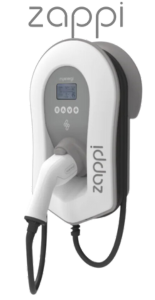
Zappi
EV Charger
Office in Australia:
Yes
Made In:
United Kingdom
Solar Choice Score:
Warranty:
3 years
Approximate Retail Price:
From $1,200
Open Charge Point Protocol (OCPP):
Yes
Solar System Integration:
Yes
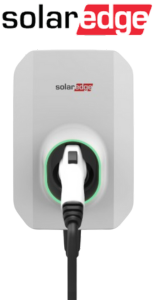
SolarEdge
EV Charger
Office in Australia:
Yes
Made In:
China
Solar Choice Score:
Warranty:
5 years
Approximate Retail Price:
From $1,850
Open Charge Point Protocol (OCPP):
No
Solar System Integration:
Yes with SolarEdge inverter

Evnex
EV Charger
Office in Australia:
No
Made In:
New Zealand
Solar Choice Score:
Warranty:
3 years
Approximate Retail Price:
From $1,268
Open Charge Point Protocol (OCPP):
Yes
Solar System Integration:
Yes via included CT

Fronius
EV Charger
Office in Australia:
Yes
Made In:
Austria
Solar Choice Score:
Warranty:
2 years
Approximate Retail Price:
From $1,900
Open Charge Point Protocol (OCPP):
Yes
Solar System Integration:
Yes requires Fronius Smart Meter

Ocular
EV Charger
Office in Australia:
Yes
Made In:
China
Solar Choice Score:
Warranty:
2 years
Approximate Retail Price:
From $1,200
Open Charge Point Protocol (OCPP):
Yes
Solar System Integration:
Yes
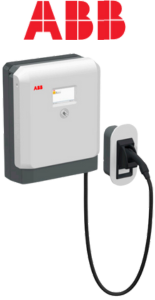
ABB
EV Charger
Office in Australia:
Yes
Made In:
China
Solar Choice Score:
Warranty:
2 years
Approximate Retail Price:
From $1,950
Open Charge Point Protocol (OCPP):
Yes
Solar System Integration:
Yes

GoodWe
EV Charger
Office in Australia:
Yes
Made In:
China
Solar Choice Score:
Warranty:
2 years
Approximate Retail Price:
From $800
Open Charge Point Protocol (OCPP):
No
Solar System Integration:
Yes, with additional hardware
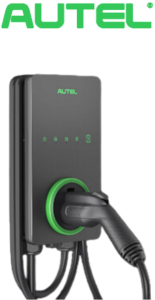
Autel
EV Charger
Office in Australia:
Yes
Made In:
China
Solar Choice Score:
Warranty:
3 years
Approximate Retail Price:
From $800
Open Charge Point Protocol (OCPP):
Yes
Solar System Integration:
No

Wallbox Pulsar
EV Charger
Office in Australia:
No
Made In:
China
Solar Choice Score:
Warranty:
3 years
Approximate Retail Price:
From $1,500
Open Charge Point Protocol (OCPP):
Yes
Solar System Integration:
Yes
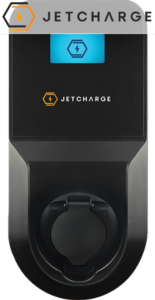
JET Charge
EV Charger
Office in Australia:
Yes
Made In:
Australia
Solar Choice Score:
Warranty:
3 years
Approximate Retail Price:
From $1,650
Open Charge Point Protocol (OCPP):
Yes
Solar System Integration:
Yes
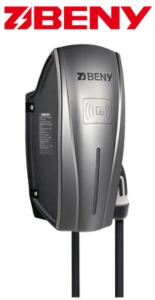
ZJ Beny
EV Charger
Office in Australia:
No
Made In:
China
Solar Choice Score:
Warranty:
3 years
Approximate Retail Price:
From $975
Open Charge Point Protocol (OCPP):
Yes
Solar System Integration:
Yes with additional hardware
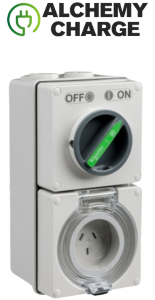
Alchemy Charge
EV Charger
Office in Australia:
Yes
Made In:
Australia
Solar Choice Score:
Warranty:
Lifetime, if remain subscribed years
Approximate Retail Price:
$299
Open Charge Point Protocol (OCPP):
No
Solar System Integration:
No
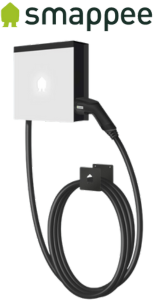
Smappee
EV Charger
Office in Australia:
No
Made In:
Belgium
Solar Choice Score:
Warranty:
2 years
Approximate Retail Price:
From $1,500
Open Charge Point Protocol (OCPP):
Yes
Solar System Integration:
Yes
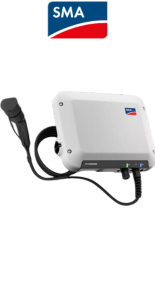
SMA
EV Charger
Office in Australia:
Yes
Made In:
Germany
Solar Choice Score:
Warranty:
5 years
Approximate Retail Price:
$2,500
Open Charge Point Protocol (OCPP):
No
Solar System Integration:
Yes with SMA inverter
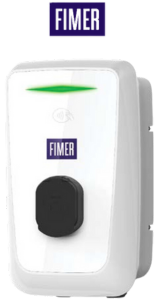
FIMER
EV Charger
Office in Australia:
Yes
Made In:
Italy
Solar Choice Score:
Warranty:
2 years
Approximate Retail Price:
From $1,949
Open Charge Point Protocol (OCPP):
Yes
Solar System Integration:
Yes

Schneider
EV Charger
Office in Australia:
Yes
Made In:
China
Solar Choice Score:
Warranty:
2 years
Approximate Retail Price:
From $1,350
Open Charge Point Protocol (OCPP):
Yes
Solar System Integration:
Yes
Home EV Charger installation considerations
Each home is different, but here are some of the factors that will change the price:
- The distance from your main switchboard to the EV charger location. Due to the high electrical demand of an EV Charger, your electrician will need to pull a new circuit from the main switchboard with its own breaker. The length and difficulty of this cable run will impact some of your costs.
- 3-phase or 1-phase EV charger. Three-phase charging solutions require bigger cables and can require additional work at your switchboard to enable the new circuit.
- Outdoor and ground-mounted EV Chargers. If you want your charger to be mounted on your driveway, then you are looking at a more expensive install to cover the trenching, pole-mounting and weatherproofing the EV charging solution.
But how much does it cost to actually charge your EV? The cost of charging an electric vehicle depends on factors like electricity rates, battery capacity, and charging speed. Read our guide on how much it costs to charge an EV to understand the ongoing costs associated with home and public charging.
Ready to get an EV charger installation quote?
Compare quotes for an EV chargers from pre-vetted installers near you
Take charge with your new EV
What if I live in an apartment?
Can I save on EV Charging Costs with solar?
By leveraging solar energy, EV owners can significantly reduce their charging costs. For a comprehensive breakdown of EV charging expenses and potential savings, read our guide on how much it costs to charge an EV in Australia.
- Solar Panel Costs: Solar Choice Price Index | April 2025 - 1 April, 2025
- Solar Panels For Homes – All You Need to Know About Solar Systems - 18 March, 2025
- Best NSW Solar Feed-In Tariffs - 17 March, 2025
